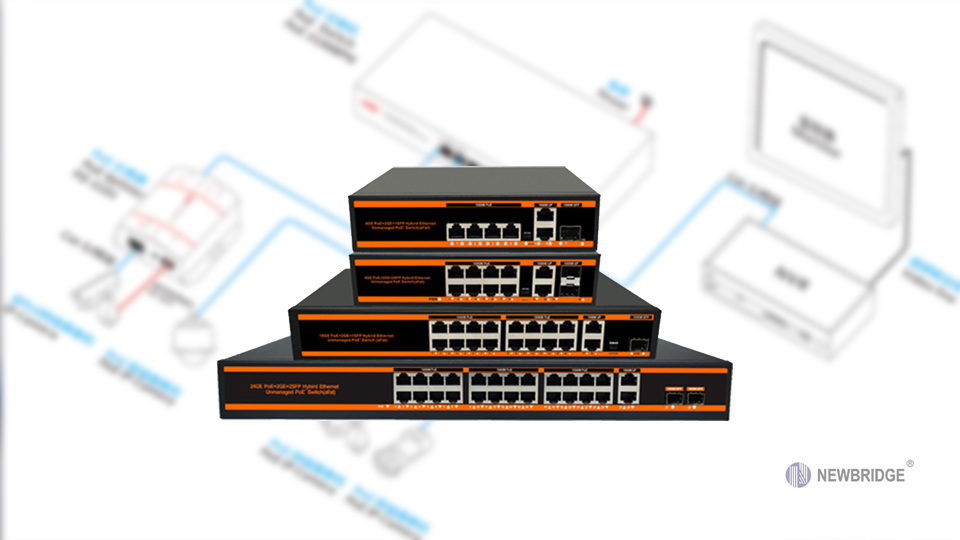In enterprise network construction, PoE switches are key devices, and their selection directly affects the stability and scalability of the network. So, how to choose a PoE switch suitable for enterprise networks? Below is a detailed introduction for you.
PoE switch is a network device that can provide power supply and data transmission to terminal devices (such as IP phones, wireless APs, network cameras, etc.) simultaneously through Ethernet cables. Its biggest advantage is that there is no need to deploy power cords separately for each device, greatly simplifying wiring complexity, reducing construction costs and maintenance difficulties, while also making the office environment cleaner.

Clearly define power requirements
When choosing a PoE switch, enterprises should first consider the power requirements of the device. The power of different terminal devices varies. For example, the power of a regular IP phone is usually below 10W, while the power of a high-definition network camera or high-power wireless AP may reach 20W or even higher. When calculating the total power, it is necessary to calculate the sum of the power of all connected devices and reserve a certain amount of redundancy. It is generally recommended to reserve about 30% of the power margin to cope with future device increases or power fluctuations. If the total power of the selected PoE switch is insufficient, it may cause some devices to be unable to supply power normally, affecting the normal operation of the network.
Determine the number of ports
The selection of port quantity should be based on the current number of devices connected to the enterprise and future expansion plans. On the one hand, it is necessary to ensure that the IP phones, wireless APs, cameras, and other devices that currently require access have corresponding ports available; On the other hand, sufficient ports should also be reserved for potential future devices. If the number of ports is too small, when the enterprise expands its business, it needs to replace the switch, which not only increases costs but may also affect the stability of the network; However, having too many ports can result in resource waste and increased costs. Generally speaking, the number of ports can be selected based on 1.5-2 times the current number of devices.
Pay attention to power supply standards
The commonly used PoE power standards currently include IEEE 802.3af and IEEE 802.3at (also known as PoE+). The maximum power supply of IEEE 802.3af standard is 15.4W, which is suitable for devices with low power requirements, such as ordinary IP phones, small wireless APs, etc; The maximum power supply of IEEE 802.3at standard can reach 30W, which can meet the power supply needs of high-power devices such as high-definition cameras, large wireless APs, etc. When selecting a PoE switch, it is necessary to determine the power supply standard supported by the connected terminal device to ensure compatibility between the switch's power supply standard and the device. If the power supply standard of the switch is lower than the equipment requirements, the equipment will not work properly; If the power supply standard is too high, although the equipment can work normally, it may cause energy waste.
Consider network performance
The network performance of switches directly affects the data transmission speed and stability of enterprise networks. When considering network performance, it is important to pay attention to the following key parameters:
Forwarding rate: Forwarding rate refers to the number of frames of data that a switch can forward per second, usually measured in PPS (packets per second). The higher the forwarding rate, the stronger the data processing ability of the switch, and the lower the network latency.
Backplane bandwidth: Backplane bandwidth is the bandwidth of the internal bus of the switch, which determines the amount of data that the switch can process simultaneously. The larger the backplane bandwidth, the better the overall performance of the switch, especially when multiple ports are transmitting data simultaneously, which can avoid congestion.
Switching capacity: Switching capacity refers to the total bandwidth of all ports of a switch, which reflects the overall data exchange capability of the switch. When choosing a PoE switch, it should be ensured that its switching capacity can meet the bandwidth requirements of the enterprise network.
Value brand and after-sales service
Choosing a well-known brand of PoE switch usually ensures better product quality and performance. Famous brands undergo strict testing and quality control during the research and production process, and are able to provide stable and reliable products. Meanwhile, well-known brands often have a comprehensive after-sales service system, including technical support, troubleshooting, equipment upgrades, etc. When there are problems with the enterprise network, it is possible to receive professional help in a timely manner to reduce losses caused by network failures. When choosing a brand, you can refer to market evaluations, user feedback, and evaluation reports from professional institutions.
In short, choosing a PoE switch suitable for enterprise networks requires comprehensive consideration of power requirements, port quantity, power supply standards, network performance, brand, and after-sales service. Only by carefully analyzing various factors based on the actual needs of the enterprise can suitable PoE switches be selected, laying a solid foundation for the stable operation and future development of the enterprise network. If you want to learn more about PoE switches, please visit Newbridge official website. We will provide you with professional solutions and high-quality services.
